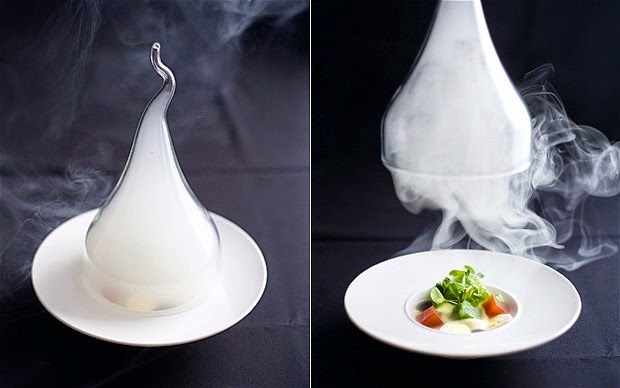 |
What is innovation? Innovation is
defined as “something original, new, and important in
whatever field that breaks in to a market or society. It can be viewed as the
application of better solutions that meet new requirements, in articulated
needs, or existing market needs and accomplished through more effective
products, processes, services, technologies, or ideas that are readily
available to markets, governments and society.”
Innovation is achieved in 5 ways:
- Service
- Product
- Processes
- Technology
- Ideas
An example
of innovation in the culinary industry would be Molecular Gastronomy. Molecular
gastronomy is “a sub discipline of food science that seeks to investigate the
physical and chemical transformations of ingredients that occur in cooking.” It includes three sections, which are social, artistic and
technical. Hervé This
(1955 – Present), a French physical chemist born in Suresnes, Hauts de Seine
and Nicholas Kurti (1908-1998) a Hungarian - Oxford physicist formulated the
term Molecular Gastronomy in 1988. Molecular cuisine is a modern style of
cooking, and takes advantage of many technical innovations from scientific
disciplines.
 |
| www.shiftgig.com |
Molecular
Gastronomy falls under processes, one of the categories listed above in which
innovation is achieved. In chemistry, all matter is classified into three
groups, elements, compounds and mixtures. All prepared food dishes in the culinary industry are examples
of a mixture known as a colloid.
"A classic example
of a colloid would be ice cream, which is made by churning a mixture of milk,
eggs, sugar and flavourings as it is slowly chilled. The churning disperses air
bubbles into the mixture by foaming and breaks up large ice crystals. The
result is a complex substance involving solids, liquids and gases in at least
two."
Molecular
Gastronomy or Modernist Cuisine popularized by Nathan Myhrvold has been taken up
by Chefs Heston Blumenthal, Wylie Dufresne, Grant Achatz and Homaro Cantu and
other chefs who continue to experiment and to explore what science and
technology can contribute to food and food presentation.
 |
Another
example of innovation in the culinary industry would be Sous Vide. New
technologies from transportation to food processing had an overwhelming effect
on cooking in the 20th century.
Sous Vide (“under vacuum”) started out as a “method for packaging and
storing foods in vacuum – sealed plastic bags.” However, Modern chefs are now
exploring new ways to use this technology to control cooking temperatures and
times with extreme precision.” As a result of Sous Vide familiar foods have
emerged with new textures and flavours.
Understanding
the physical and chemical transformation of ingredients that occur in cooking
and using the technology sous vide as a practice of cooking will help me as a
future chef explore what science and technology can contribute to food and food
presentation as well as explore the different textures, and make use of
unfamiliar ingredients and familiar ingredients to create new textures and
flavours.
Source:
·
Gisslen, W. (2014). Chapter 1. In Professional
Cooking 8th Edition (pp.7). New Jersey: Jon Wiley &
Sons, Inc.
·
HOSF1031 - Theory of Food II Week 13 Innovation
Power Point
No comments:
Post a Comment